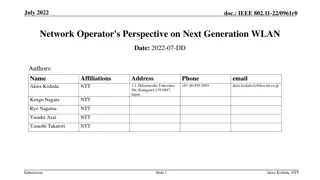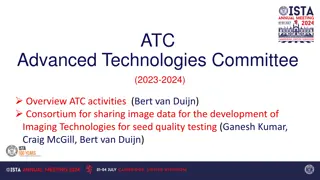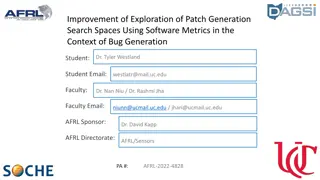Challenges and Proposed Solutions in Next-Generation Vehicle Technologies
The document discusses the background of IEEE 802.11 NGV technologies, focusing on the need for a new 10 MHz PHY for DSRC systems. It highlights issues related to channelization and introduces new PHY capabilities in 802.11n, 802.11ac, and draft 802.11ax standards, offering insights into evolving features for wireless transmissions in NGV applications.
Download Presentation

Please find below an Image/Link to download the presentation.
The content on the website is provided AS IS for your information and personal use only. It may not be sold, licensed, or shared on other websites without obtaining consent from the author.If you encounter any issues during the download, it is possible that the publisher has removed the file from their server.
You are allowed to download the files provided on this website for personal or commercial use, subject to the condition that they are used lawfully. All files are the property of their respective owners.
The content on the website is provided AS IS for your information and personal use only. It may not be sold, licensed, or shared on other websites without obtaining consent from the author.
E N D
Presentation Transcript
May 2018 doc.: IEEE 802.11-18/0907r0 802.11 NGV Background and some problems to solve Date: 2017-05-07 Authors: Name James Lepp Affiliations BlackBerry Address 1001 Farrar Road Ottawa, Canada Phone +1-613-595-4156 email jlepp@blackberry.com Submission Slide 1 James Lepp, BlackBerry
May 2018 doc.: IEEE 802.11-18/0907r0 Abstract The 802.11a and 802.11p technologies that make up DSRC systems: PHY: 802.11a: The 10MHz PHY MAC: 802.11p: Operation Outside the Context of a BSS (OCB) Some problems for NGV to solve. Submission Slide 2 James Lepp, BlackBerry
May 2018 doc.: IEEE 802.11-18/0907r0 10MHz PHY DSRC operates in 10 MHz and 20 MHz channels in the 5.9 GHz band In the USA this is regulated by FCC Part 90 Subpart M https://www.ecfr.gov/cgi-bin/text-idx?node=sp47.5.90.m (Roadside Units) FCC Part 95 Subpart L https://www.ecfr.gov/cgi-bin/text-idx?node=sp47.5.95.l (On-Board Units) And similar regulations in other countries, but one key takeaway from these regulations is the 10 MHz channelization In IEEE 802.11-2016 the only 10 MHz PHY is the 802.11a PHY described in clause 17. The clause 19 (HT / 11n) PHY describes 20 and 40 MHz channels The clause 21 (VHT / 11ac) PHY describes 20 MHz and wider channels. The main thing NGV needs to do is define a new 10 MHz PHY. Submission Slide 3 James Lepp, BlackBerry
May 2018 doc.: IEEE 802.11-18/0907r0 10 MHz PHY from 802.11a-1999 *From IEEE Std 802.11-2016 Note that of the 8 rates in the table, 3, 6 and 12 Mb/s are mandatory rates. Submission Slide 4 James Lepp, BlackBerry
May, 2018 doc.: IEEE 802.11-18/0907r0 New PHY Capabilities In the next few slides I present the PHY capabilities information field from 802.11n, 802.11ac and draft 802.11ax. This shows, at a high level, the new features added to newer PHYs. In particular, the new features that required capability to be communicated (when joining a BSS). It also highlights the increasing diversity of PHY features available to 802.11 stations to use when transmitting frames. Submission Slide 5 James Lepp, BlackBerry
May 2018 doc.: IEEE 802.11-18/0907r0 802.11n (HT) PHY Capabilities *From IEEE Std 802.11-2016 Submission Slide 6 James Lepp, BlackBerry
May 2018 doc.: IEEE 802.11-18/0907r0 802.11ac (VHT) PHY Capabilities *From IEEE Std 802.11-2016 Submission Slide 7 James Lepp, BlackBerry
May 2018 doc.: IEEE 802.11-18/0907r0 802.11ax (HE) PHY Capabilities DRAFT *From IEEE 802.11ax D2.2 Submission Slide 8 James Lepp, BlackBerry
May 2018 doc.: IEEE 802.11-18/0907r0 PHY Issues for NGV SG to solve 1) Which of the 11n, 11ac (and 11ax?) PHY enhancements are needed by automotive applications? 2) Which of the 11n, 11ac (and 11ax?) PHY enhancements can be used in 10 MHz channels? I. II. Which can be used unchanged? Which require changes? Should the changes be done within Clause 19 (HT 11n) or Clause 21 (VHT 11ac), or a new PHY Clause specific to NGV? Submission Slide 9 James Lepp, BlackBerry
May 2018 doc.: IEEE 802.11-18/0907r0 802.11p Operation outside the context of a BSS allows two modes: Broadcast information addressed to all STAs within vicinity. Unicast information addressed between a pair of STAs. Example DSRC applications: Basic Safety Messages (BSM) Signal Phase and Timing (SPaT) Wave Service Announcement (WSA) Broadcast information V2V Broadcast information from stoplights Broadcast information about services These applications which are in use today typically use broadcast, and typically use a fixed MCS rate. Submission Slide 10 James Lepp, BlackBerry
May 2018 doc.: IEEE 802.11-18/0907r0 802.11p capability negotiation The broadcast nature of these transmissions means there may be no ability to negotiate capabilities with the intended receiving STAs. Lack of capability negotiation may affect the backwards/forwards interoperability of new PHY technologies. Submission Slide 11 James Lepp, BlackBerry
May 2018 doc.: IEEE 802.11-18/0907r0 A specific problem 10.7 Multirate support 10.7.1 Overview Some PHYs have multiple data transfer rate capabilities that allow implementations to perform dynamic rate switching with the objective of improving performance. The algorithm for performing rate switching is beyond the scope of this standard, but in order to provide coexistence and interoperability on multirate-capable PHYs, this standard defines a set of rules to be followed by all STAs. Only the data transfer rates of the mandatory rate set of the attached PHY are guaranteed to be supported when a STA for which dot11OCBActivated is true transmits a Management or Data frame. A higher layer protocol entity within a STA in which dot11OCBActivated is true might negotiate a rate outside the mandatory rate set. *From 802.11-2016 Multirate behavior of STAs for which dot11OCBActivated is true may need updating by NGV. Even if we were to punt this to a higher layer protocol entity to do the negotiation, what changes are needed to 802.11 to support using new rates? Submission Slide 12 James Lepp, BlackBerry
May 2018 doc.: IEEE 802.11-18/0907r0 Summary PHY: The main thing NGV needs to do is update the 10 MHz PHY. (from clause 17) There are many features in 11n, 11ac and 11ax to choose from. (HT, VHT, HE) MAC: NGV also needs to address backwards interoperability, compatibility, coexistence etc. Submission Slide 13 James Lepp, BlackBerry
May 2018 doc.: IEEE 802.11-18/0907r0 References https://mentor.ieee.org/802.11/dcn/18/11-18-0513-02-0wng-802-11-for-next- generation-v2x-communication.pptx IEEE 802.11-2016 IEEE 802.11ax D2.2 Submission Slide 14 James Lepp, BlackBerry























